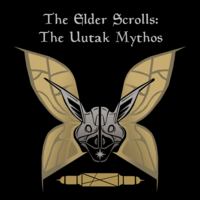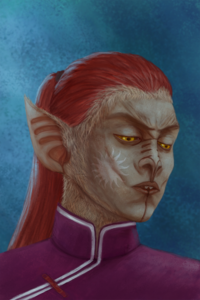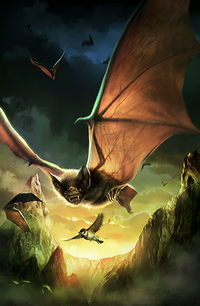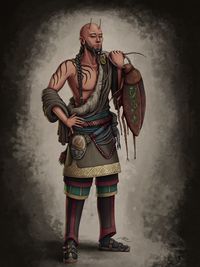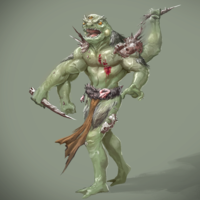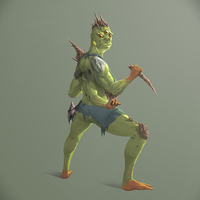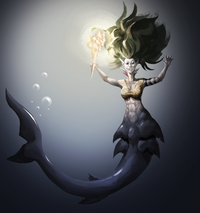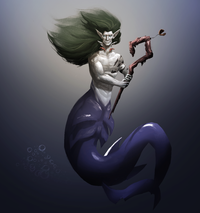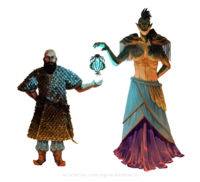General:Uutak Mythos/Races
- "The Yneslean archipelago might be host to some of the most unique civilized races the Empire has encountered since its earliest expeditions into the unknown. While archaeologists and intrepid travelers have determined that Lapis Lazuli used to be home to at least seven different cultures during separate periods of time, only four have survived and persisted throughout the eras to form the economical and industrial stronghold that is the Yneslean Directorate." — Anonymous, The Emperor's Guide to Yneslea, 2nd Edition
The Uutak Mythos, being a collaborative world-building project that runs concurrently with the main installments and various spin-offs of the Elder Scrolls franchise, attempts to fit itself flawlessly into the in-universe narrative that is the Aurbis. In order to flesh out the islands of Yneslea and Cathnoquey in the setting, it was deemed crucial to create native inhabitants that could quite easily be seen as being a "natural" occurrence in the games' setting. Finding the right mixture of "detailed, newcomer-friendly, and easily explainable" information with "more than what meets the eye, intriguing, and deeper" lore aspects was admittedly tough for project creators and new team members alike, but a perfect balance was found that left newcomers with the capacity to understanding the basics of the projects' creation while also leaving them with a thirst for more. Read on to learn information about the races introduced by the Uutak Mythos: the Echmer, the Hyu-Ket, the Broh-Kah, and the Terenjoe on Yneslea, and the Chimeri-quey, Men-of-Keptu-quey and the Ishalshi on Cathnoquey.
Note: As of 12/21/2020, this page is considered incomplete and in the process of being expanded.
Contents
The Echmer[edit]
- "Do you know why we don't accept your philosophy? Because in the end after all of the prose and niceties you spout it's centered around the concept of 'it's all about me'. I, and by extension my people, don't like that. If you only take the things you like out of something and focus on them while ignoring everything and everyone else your 'House of WE' will eventually become the 'House of I' in due time, and you'll grow old and stagnate. That's a road that we Echmer do not want to walk down again. What's the point of being a community, of being a family, if we look behind closed doors and see that we are all only bound by a mutual love for something, and not each other? That is why I will lead the Echmer to the 'House of ALL'...and leave the way opened so that you may hopefully follow." — Inati Della'I to Jubal-lun-Sul during the events of An Uutak C0DA
Known for their dry wit and isolationist tendencies, the Echmer (pronounced [/ek-mer]) are, without question, the most dominant race of their homeland; the Yneslean archipelago. While they are phenomenal engineers, and great lovers of the creative arts (the celebration of song and instrument in particular), they also serve as the leaders of the Yneslean Directorate, largely due to the more tribal characteristics of their fellow native neighbors. During their time spent as Imperial vassals, Emperor Uriel VI and the rest of the Empire's territories selected the Echmeri race to be their representatives on the Elder Council, from 3E 318 until they seceded from the Empire in 4E 19. After this secession, the prominent eastern island-nations of the archipelago (such as Cathnoquey, Roscrea, and Esroniet) formally requested that the Echmer remain as the Padomaic's primary governing body for western contact. This unanimous decision would make Yneslea the strongest non-continental civilization known to the Empire (aside from Pyandonea to the south and Akavir, with the latter's economy and military being unknown as recent delegations continue to be repelled). This would not mean, however, that the island-nations would serve as client-states underneath the Directorate. As of 4E 201, the Yneslean Directorate, and therefore the Echmer, remain neutral in regards to the affairs between the Fourth Empire of Man and the Third Aldmeri Dominion.
In ages long since passed, the Echmer viewed all foreigners to the archipelago as potential threats, who needed to be removed or otherwise slain, lest they ran the risk of losing everything they fought so boldly to defend. They feared for the lives of their loved ones, and for the purity of their known world. But, as the centuries trudged onward, their attitudes toward the other races improved dramatically. As they gradually became exposed to the sentient populations of their neighboring island-nations, as well as learning snippets of information about Tamriel from a few daring pilots and explorers, they had no choice but to become more worldly. They're still suspicious of strangers even today, but their general demeanor toward outsiders has warmed considerably, thanks to their brief period of time as Imperial citizens within the Third Empire.
The native tongue of the Echmer utilizes words and sounds inherited from the Dwemeris (and therefore Aldmeris) language system. Over the years, this language transformed into what they refer to as Ek'hi (pronounced [/ek-hee]), meaning that their racial name can be translated similarly to their merish cousins. The prefix "ech-" in Aldmeri primarily means "euphonic", but can also mean "harmonious", "reverberate", or "echoic" depending on the context and usage. Therefore, the most agreed upon translations of Echmer, when its elvish nature is taken into account, are the "Euphonic Folk", the "Harmonic Folk", and the "Echo Folk". The latter is perhaps the most symbolic translation, as the Echmer are—without much debate—the last living echoes of the Dwarves.
Unfortunately, however, when Uriel VI brought the Yneslean Lanes under rule of the Empire it resulted in a severe linguistic issue. Due to their chiropteran nature, the word "ech" became mistranslated as "bat", and "Echmer" subsequently became known as "Bat Folk" throughout Tamriel. (In actuality, the Aldmeris prefix "khao-" means bat, so the correct term to use would have been "Khaomer"). While the Echo Folk are fully aware they indeed descend from ancient bats who once populated the caverns of Yneslea, they were startled and frustrated upon hearing that the other races of Tamriel could focus only on their outward appearance to understand their unique civilization. It wasn't until they recognized their place in a unified and greater world that they began to use the name "Echmer" themselves, with an emotion they deny as pride.
Origins and Physiology[edit]
A common misconception held by most people of Tamriel, even amongst those involved in literary works or even magical academia, is that the Echmer are literal elves or "mer". This is simply not true—at least, not in the conventional sense of truth. In actuality, the "Echo Elves" once lived as common bats who thrived and flourished within the subterranean caverns of the Yneslean archipelago. Unlike most other races of Nirn, who were shaped and molded by Aedra or Daedra, it was only through the mysterious acts of a Dwemeri splinter group, known as Clan Noraken, that they would one day "change" and evolve into what we now know as the Echmer. This remarkable Dwemeri Clan traveled eastward from Tamriel and made landfall on the western coast of ancient Yneslea. Some discerning scholars believe this landing to have been a result of some schism the clan may have had with their brethren, who mostly chose to live within the depths of Tamriel, save for a few outer-realm travelers.
Through the use of archaic sound magic, which has unfortunately been lost to the ages, the Noraken were able to accelerate the natural growth rates and multiply the intelligence levels of Yneslean bats at an alarming pace. No one, not even the Echmer themselves, are quite sure what motivated the Dwemer Clan to do this. After all, the Deep Folk were an odd, curious, and often hostile people. Some antiquitarians believe the Noraken were simply trying to create the ultimate slave-race, while others believe the Echmer may have been an experimental prototype for the Noraken. Their reasoning for this theory is that by learning to intervene in their own evolution, the Dwemer could evolve beyond their need for automatons and vamidiums. While either of these theories could be true, it's now known without a shadow of a doubt that these biological experiments paved the way for the Echmer to become the merish intellectuals they are now in the wake of the Disappearance of the Dwarves in 1E 700.
The Echmer divide themselves into three distinct subspecies based on their physical attributes: the ek'imaas ("we sound of beasts"), the ek'idwes ("we sound of ancients"), and the ek'lilith ("we sound of the sun"). The ek'imaas are large and bestial, with their skull and facial structure being notably more chiropteran-like than the ek'idwes, who are slightly smaller but more "elvish" in appearance when compared to their relatives. Meanwhile, the ek'lilith are particularly unique as they have an even shorter stature than the ek'idwes, as well as a more vulpine head and body shape. This is an effect of also being descendants of Lilmothiit survivors of the Knahaten Flu who managed to land in the archipelago and subsequently interbreed with the Echmer population during the Second Era.
The average Echmer, no matter the gender, stands at a height of around five to six feet, and weighs in at around 100 - 300 Imperial pounds. Depending on their profession and lifestyle, they tend to be naturally slim and well-muscled; boasting greater physical strength than their more merish cousins, save for the Orcs, or Orsimer). Underneath the light-fur that covers their bodies, which ranges anywhere from shades of orange, brown, white, grey, and black, their skin tends to be of darker tones. Echmer often dye their fur in patterns similar to tattoos and prefer to stylize their hair in various types of braids, dreadlocks, ponytails, and mohawks, although baldness is quite common as well. The Echmer are also quite long-lived, with their average lifespan being between 100 - 250 years, although reaching the ripe old age of 300 or higher has been recorded before, according to Ysneslean death records.
The senses in which the Echo Folk begin to noticeably differ from the other civilized races are sight and hearing, due to their chiropteran heritage giving them a clear-cut advantage in these biological areas. The rumor that the Echmer are all born blind is just that—a rumor. While it is true that they naturally see better at night than during the day, the bat elves can still perceive light and color as other races do, and are prone to wearing physician-approved spectacles to enhance their vision. These spectacles are often made to compliment the exotic and metallic colored hues—gold, silver, bronze, brass, aluminum, copper, and iron being common, and chromatic yellows, oranges, reds, purples, blues, and greens being rarer—of their eyes).
Furthermore, what they lack in vision they more than compensate with their ears and a biological trait known as "echolocation". Bats in general are known for their exceptional hearing, being capable of detecting and decoding sounds that other species are incapable of even registering, and the Echmer are no exception to this. The common saying, "Does a tree still make a sound when it falls in a forest with no one around to hear it?" becomes humorous with an Echo Elf around, who will have definitely heard it from within a reasonable distance of the forest. Another perk which comes from their echolocation is the ability to "emit" sounds from their mind to temporarily illuminate dark surroundings in detail. With all of these talents at their disposal, it's considered practically impossible to sneak up on a bat elf.
Last but not least, another detail of significance is their ability to have children. Although they consider themselves a beast race, their reproductive organs are near-identical to those of actual elves, which of course means that female bat elves give birth to live young after nine months, just like the races of man and mer. A trait unique to the Echo Folk's reproductive system, however, allows them to stall childbirth for an additional three months, in case the predetermined time is not suitable, such as periods of devastating war and sickness. One to two children in a household is considered normal and Echmeri women count themselves blessed if they are able to have three. Four, however, is considered the maximum in a single lifetime.
Echkin[edit]
- "Feral creatures, no longer of civilized mind and intellect. Best to let them die now, before they dishonor themselves further." - Anonymous Echmer Adventurer
Echkin, commonly known as giant bats, are a 'mutated' strain of Echmer. During the First Era, the Yokudan goddess Hoodoc (believed to be another one of Hrahndeyl's famous guises) summoned a small army of Echmeri soldiers to aid in the Ra Gada migration to Tamriel and defeat the monsters and races that lived in the Deathlands after Yokuda sunk into the sea. The Orcs were able to successfully curse the Echmer warriors, causing them to deform, turn feral, and take up residence in the Wrothgarian Mountains. Eventually, they spread throughout Tamriel and became the giant bats of modern times, with their once-sapient origins becoming nothing more than a collection of fanciful legends and folk tales told to Redguard, Breton, and Orc children.
The Hyu-Ket[edit]
- "Ket have seen much, perhaps more than any Westerner ever has. We have sailed the bitter seas of the eastern horizons, and have clashed with the most tyrannical of dragon-kyn. But we remain humble, as all should be, for we are all a part of this cocoon. Stars fall and worlds die, but at the end, we are one." — Gol-Thek
Though they are perhaps not as famous or as recognizable as the Echmer, the aboriginal insect goblins known as the Hyu-Ket are the oldest race on Yneslea, predating even the arrival of the Noraken Dwemer by several centuries. The Hyu-Ket originated on Tamriel with the rest of goblin-kind and journeyed East across the Padomaic Ocean and landed on the islands later known as Hrahn's isles where they made their homes. Originally preferring a simple hunter-gatherer society, they would eventually be enslaved wholesale by the Echmer Cakophon monarchy and remain in bondage until the third era. By the fourth era, the emancipated Hyu-Ket exist in two worlds: Some returned to the forests and wilderness of Yneslea in an attempt to regain a piece of their cultural heritage that they had lost, but the majority continued to live in the cities of their former masters and integrated into Echmer society,
The Hyu-Ket were once indistinguishable from the goblins that still roam Tamriel. However, through exposure to a now extinct mutagenic mushroom, their forms took on insectile features. They stand slightly taller than Tamrielic goblins with brownish-red skin. They have the characteristic bulbous noses of goblins and enormous compound eyes that can be a variety of scintillating colors like green, blue, pink, and red. Their insectile features are further augmented by a pair of antennae that protrude from their forehead and chitinous growths on their joints. Despite their monstrous appearance and goblin origin, the Hyu-Ket are not a warlike people. They much prefer to trade and learn from their neighbors, taking up arms only when they or their homes are threatened.
The Kítapoe[edit]
- "It is unfortunate that the Kítapoe of In'eslae died out thousands of years ago. The Insect Men that originally hailed from the Dragon Land seemed to have possessed an amazing wealth of celestial knowledge, even if it some it fills this old man with the mundy wundies on occasion." - Hasphat Antabolis
The Kítapoe were a race of Akaviri Men that dwelled in the archipelago-continent of Yneslea, who worshipped the un-star constellations and an incomprehensible alien deity from beyond the multiverse they called the Tenebrous God. While they built cities and temples, they were also semidominantly nomadic and preferred traveling in communal groups for activities such as hunting and gathering despite having permanent lodgings. They were also quite friendly to nonhostile peoples and were quick to strike up trade routes and societal progression with others. Unfortunately, however, their worship in these vaguely evil deities left them cursed and they were prone to race-wide moments of depression and melancholy. Eventually, they all disappeared in the interim between the Late Merethic Era and the Early First Era due to mysterious purposes, leaving only strange shrines and temples to their gods behind. It is rumored that the insectoid, parasitic monstrosities known as the Peine may have either devoured them all or are what the Kítapoe ultimately became.
From a real-life standpoint, the Kítapoe have strong Tibetan influences in regards to physique and culture, but these attributes have been adjusted to fit a more tropical/subtropical/semi-arid climate. They are distinctively Asian-looking appearance-wise, have six fingers instead of five (one thumb, an index finger, a middle finger, another index finger instead of a pinky, and then another thumb), bug-like eyes (similar to those of a fly, but human-shaped to add an uncanny feeling to their expressions), and two small antennae-like attachments that rested above their temples. Their skin tone ranges from a light, orange-brown to a darker variant of orange-brown, and they prefer wearing wooden sandals and free-flowing clothing (their clothes were made from the various species of bugs they brought over from Akavir in ancient times before they too met their end).
The Broh-Kah[edit]
- "(Incomprehensible roaring)...lahndurz blid HAARD, bohnes gu brrek...(more incomprehensible roaring)." - Typical Broh-Kah
The Broh-Kah are traditionally categorized as an uncivilized race by the Western Hierarchies (the Provinces of Tamriel, the Remnants of Yokuda, the Thrassian Nations), the Padomaic Dynasties (the Emperial Territorial Islands, the Yneslean Directorate), the Oceanic Freelands, and the southern Pyandonean Denominations; one that can never ascend to true civilized status due to their inherent biological drive for savagery and simple-minded intellect. In truth, it is strongly implied through rare conversational interaction and their utterly bizarre hieroglyphic language system that the Broh-Kah are not originally from Nirn, having chased their ancient foes (the dreugh) across universes or worlds until they became trapped in this one. Ironically, it is unknown if the Broh-Kah have their own native name for their people as they have never given it to anyone-they were instead named after the god of war and water they constantly scream praise to in battle.
Physically the Broh-Kah are a race of amphibious frog-like humanoids who can be found predominately inhabiting the ancient dreugh kingdoms underneath the Yneslean archipelago after they wiped their previous inhabitants from existence. Their skin tends to be hued in various mottled green and yellow colors, while also being covered in swaths of brown, black, or gray fur (normally around the neck, upper forearms, and upper thighs). The Broh-Kah are unique because it has been proven by scholars and alchemists that they are constantly undergoing cellular regeneration akin to trolls, meaning that they never stop growing and are prone to unnatural mutations. A standard race-wide mutation that occurs when a Broh-Kah reaches its adult cycle (which takes place five or so years after it hatches from an egg) is the growth of spiky bone marrow on the outside of their bodies (normally around the shoulders, torso, knees, crotch, and ankles) that acts as a natural armor for their kind. Because this bone is still very much connected to their central nervous systems, you'd think that they wouldn't be as aggressive as they are but this simply isn't the case; their natural regeneration properties combined with their absurd resiliency to pain means that the Broh-Kah often rip out these bones from their skin and carve instruments and weapons from them in a terrifying show of barbarism.
Another physical trait to remember about the Broh-Kah is that they are four-armed and naturally well-muscled as a species, with their hands having two thick fingers and one equally thick thumb, and the four toes of their feet being webbed. Male and female Broh-Kah bear the usual feminine and masculine physical differences found in other humanoid races, and traditionally use the scales of sea creatures and coral to make simple clothing or decorate their bone growths. The frog-people do not grow head-hair and are usually bald, although a few eccentric ones will sculpt bone growths on their head into various shapes and styles to intimidate the civilized peoples of Nirn. Broh-Kah also have a third eye in the center of their forehead which serves two purposes: to biologically emit light in the dark, and to serve as a catalyst for telekinetic spells by their shamans in a manner similar to how a normal mage would use a staff or a wand.
As noted before, the Broh-Kah are simple-minded folk. It is hard to call their "society" truly evil since it seems to be a spiritual and physical need for their people to fight and kill other people, and because of that they are normally seen as annoying bandits, pillagers, and pirates who create conflicts simply to have conflicts. The only exceptions to this rule are the Apex-Kahs, rare Broh-Kahs who are born with a mutation that causes their intellect to rapidly wise the more they physically grow (meaning that they can potentially become both incredibly monstrous and dangerously intelligent the longer they are kept alive). Apex-Kah will learn foreign languages, teach these languages and other types of critical thinking to their dumber cousins, and then stylize themselves as "Wave-Lords" in order to start a valanga (a word in their tongue that means "great, bloody war").
The Terenjoe[edit]
- "The Reef Father shelters all, air-walker. Even you may come to call the sea your paradise some day, if it harkens you to it." - Mistress Gheariza, Terenjoe Ambassador to the In'eslean Directorate
The Terenjoe, also known as the Shark-Folk of Lapis Lazuli, are a race of semi-aquatic beastfolk who (like the Broh-Kah) also dwell in the ancient underwater ruins beneath the Yneslean archipelago. Although incredibly shy, creative, and well-mannered when approached, they are still well-known throughout the East for being incredibly territorial, easily offended, and quick to challenge anyone or anything that infringes on or insults their way of life. They are considered a civilized race by majority vote in longstanding Nirnic governments due to their capability and willingness to learn common language, interact with other races to (an extent), and ability to comprehend and work with metallurgical and agricultural concepts. Despite living predominantly in the waters around Yneslea, several Terenjoe tribes are wanderers by nature, and they can be found inhabiting the seas close to Cathnoquey, Esroniet, Pyandonea, and even as far west as Olenveld. They are a society of shepherds, missionaries, jewelers, and hunters who worship a strange deity known as the Reef Father, and whose main reasoning for trading with "landers" as they call them is curiosity more than any kind of monetary gain.
It is a major mystery in regards to exactly where the Terenjoe came from. Some believe that they, like the Echmer, were also a Noraken-Dwemer experiment that was abandoned and left to fend for themselves after the Disappearance of the Dwarves. Others believe that they are nature spirits who lost their divinity due to some ancient crime against the gods, or because they married into mortal blood. Regardless of what is true (as the Terenjoe view their origins as a closely guarded secret that must not be shared with anyone), the Terenjoe are very reminiscent of the fictional western mermaid that they may have inspired and are comparably similar to the centaurs of Tamriel due to being a species that has the upper half of a humanoid attached to the lower body of a creature (in their case being sharks and/or dolphins). While they can emerge their heads above the ocean to communicate with other races or even participate in some events, Terenjoe will die of suffocation if they ever fully left the sea due to their physiology. Fortunately, however, the other civilized races are working on advanced spells that might make it possible for the Shark Folk to come safely ashore for longer periods of time in the future.
While the lower shark/dolphin halves of the Terenjoe can range from a variety of different patterns, colors, and lengths in comparison to the actual shark and dolphin species of Nirn, the humanoid upper halves are generally the same in structure and form. Both male and female Terenjoe have either milky light blue/pale-white or milky light purple/pale-white skin tones with light pink or light green fish-like scales covering the lower parts of the neck, wrists, upper chest, and forehead. They have normal humanoid arms, with their fingers and thumbs being webbed (but not to the point it restricts the ability to grasp tools and weapons) and have two sets of gills on either side of their neck that helps them filter out air both above and below water. Their hair is very reminiscent of seaweed and other underwater plants and usually comes in dark shades like black or gray. Terenjoe ears are also interesting because they have two sets of them: a normal size set of elf-like ears growing out of/alongside a larger fin-like pair of ears. Like their enemies the Broh-Kah, the Terenjoe have bioluminescent eyes to see in the dark (they have no pupils, interestingly enough) and are also prone to carrying around lanterns of salt-fire to help aid in light generation. Terenjoe as a culture are very fond of superficial cosmetics and tattoos, which they make from special underwater materials. They tend to make their clothing, armor, and weapons out of coral, pearls, seaweed, and the shells of crustaceans.
The Chimeri-quey[edit]
- "We do not pity those who remained. They failed Veloth's trials, and toil in delusion that they are his truest followers, yet will never reach the Final Landing. They are not to be pitied, but reflected upon, for they are as much a part of the Trial of Death as Veloth's own, and we must learn not to fail as they did. We continued after the Trial of Death, but to think we have reached the end of our trials are to be just as delusional as them, we must continue eastward, until the Final Landing." — Ouamanapli, Wise Woman of Velotta Flotilla
The Chimeri-quey are the most well-known of the races of Cathnoquey, known for their affinity for fanaticism, mercantilism, and above all, sailing which drives them to be the public face of not just Cathnoquey, but all the peoples of the Middle Isles, despite the Directorate's legal power. Descendants of the Chimer of Morrowind, unlike most of their compatriots, they considered the death of the Prophet Veloth to be another trial, as he lived on and continued eastwards. They are, in many ways, a relic of the Dunmer's past, pressed in the mold of the Padomaic Ocean, keeping many Velothi traditions alive, as well as having been unaffected by Azura's Curse. Like their continental cousins the Ashlanders, they refute the divinity of the Tribunal of Morrowind and continue traditions dedicated to the Good Daedra, as well as the goddess of Cathnoquey, whom they name Oua. And like them, their society is organized into disparate tribes and coalitions of tribes, however, as a primarily seafaring race, these tribes largely consist of Flotilla-cities, fleets of ships that the Chimeri-quey live on, aided by Shore-Khanates which serve primarily to supply the Flotillas.
The only thing that they are known for as much as their proclivities towards trade, faith, and sea, is their territorialism. It is a well-documented matter that those who the Chimeri-quey do not wish to go beyond Cathnoquey to her neighboring islands will find their crew slaughtered and their ships integrated into a flotilla. As such, outside of military expeditions, such as those of Uriel V, the Empire - and now the Directorate, have forbidden sea voyages past Cathnoquey to all but select Merchant Dynasties on Cathnoquey, or those who can obtain passage from the powers of the Padomaic. The Chimeri-quey refuse to attack those born on Cathnoquey, as Oua forbids the inhabitants of the Archipelago from going against one another.
The Padomaic Dreugh[edit]
TBA
The Noraken Dwemer[edit]
TBA
